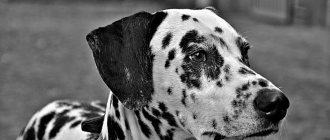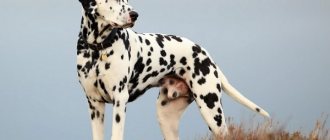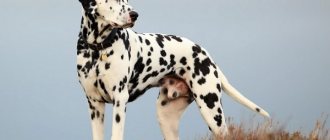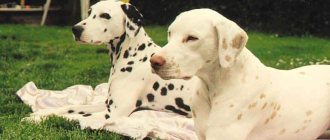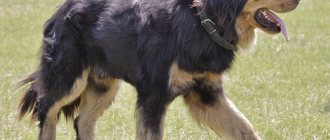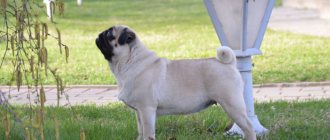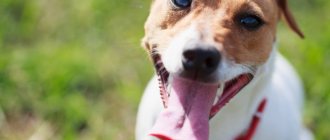It is not uncommon in advertisements for the sale of Dalmatian puppies, as well as in some documentation, to find the phrase “breeding marriage” or simply “marriage” (abbreviated as “p/b”). If we are talking about puppies for sale, then the buyer immediately has a lot of questions, since the word MARRIAGE itself is associated with inferiority, and, of course, it is important for the future owner to know in what way his four-legged companion will be inferior.
Usually we are talking about external marriage - i.e. about non-compliance with the approved FCI standard. The most common are congenital spots, blue-eyed and uncolored, in exceptional cases deafness is implied (although in most cases such puppies are euthanized).
History of the breed
Dalmatians are believed to be a very ancient breed. In excavations of sacrificial fires on the territory of today's Austria, dating back to the 2nd-3rd millennia BC, a dog's skull was discovered, very reminiscent of the skeleton of the head of a modern hound or Dalmatian. There are different opinions about the origin of the breed in its current form. Most dog handlers agree that the homeland of these animals is the territory of the former Yugoslavia, where the region of Dalmatia was located, from which their name came .
Proof of this version is that the coats of arms of many Yugoslav princes depict white dogs with black spots. From here representatives of this breed were first taken to the British Exhibition.
Since ancient times, the main purpose of these dogs was hunting, as well as accompanying and guarding their owners.
However, some historians claim that similar animals were preserved in the images of Ancient India, and in Europe they appeared along with wandering gypsies. There are researchers who are confident that Dalmatians came to us from Ancient Egypt. The latter theory seems more plausible, given that these dogs tolerate heat well.
Already in the 18th century, spotted pets were actively used in horse hunting as hounds. Representatives of the nobility bred spotted pets as carriage dogs - they ran ahead of the carriage and cleared the way. And during long journeys they protected the owners from robbers and wild animals.
Today, Dalmatians are used during earthquakes to search for people under rubble. The most interesting use for them was found in the USA: for a long time they ran ahead of fire trucks and barked to announce their appearance. Thus, they became the first sirens on fire crews. Since then, in America they have been called “fire dogs.”
In modern performances associated with early fire trucks, the Dalmatian is an obligatory participant.
Breed standard
The Dalmatian's color is white with spots. Moreover, they do not have to be black. The brown color of the spots is also considered standard. There are also tiger spots or gray spots.
One litter can produce puppies with both black and brown spots
Merged spots are valued lower than individual ones. And congenital ones are completely a sign of culling, and they are determined in an adult individual by the absence of white hairs, characteristic of acquired spots.
Main indicators of the standard:
- height of males 56–61 cm; females - 54–59 cm;
- males weigh 27–32 kg; females - 24–29 kg.
The standard places great importance on the absence of deafness. In Russia, such testing is not specifically carried out, but in America they pay great attention to it. There, hearing impairment in Dalmatians is detected in 20% of cases.
Deafness
The most terrible type of defect in Dalmatians is deafness - although the dog may not have any defects in appearance. Deaf puppies may not be recognized by novice breeders because... in other respects, they are the same as their hearing counterparts, only they do not react to sound, which is compensated by a more attentive gaze, reaction to vibration, etc. Often such puppies are euthanized when this defect is discovered.
Important! The ear canal opens in puppies at approximately 14 days. But a bad reaction to sound is not yet a sign of deafness, because... Depending on the sound, psyche and other factors, the puppy may hear the sound and react to it in a subtle way. Unfortunately, in Russia at the moment there is no test (BAER test) that gives an unambiguous answer - whether the puppy can hear or not.
author: Alena Artamonova, nursery “Alartline” (c) reprinting of material without permission of the author is prohibited
Character
It is believed that representatives of this breed tend to become attached to the owner and members of his family. The dog is sociable, active, and very clean . True, if you don’t pay attention to her, you might do something wrong or get offended.
If the owner does not work with the dog, he will find entertainment that is not always convenient for the owner. Such a pet may run far during a walk or play with illegal objects. However, in general, these animals do not cause much trouble, do not bark for no reason and get along well with children.
These dogs are curious, but not aggressive, and get along well with cats.
Walt Disney's 101 Dalmatians significantly harmed the breed
When the animated film “101 Dalmatians” was released in 1961, thousands of children demanded that their parents give them the same friend. Many adults bought puppies, but quickly realized that living with a Dalmatian is not a fairy-tale story, but harsh everyday life, full of activity and hassle in caring for the animal.
As a result, many Dalmatians were driven from their homes, and the spotted dogs were often seen roaming the streets unattended.
We also suggest finding out which 9 dog breeds get along perfectly in large families. Perhaps this is the very information about pets that will help you decide to buy a little friend.
Photo licensed from Twenty20
Pros and cons of the breed
Dalmatians have a number of undoubted advantages:
- the intelligence, kindness, and friendliness of this dog make up its special charm;
- Such a pet has an ocean of energy, and if you yourself are a fan of active walks, this is your choice;
- a young animal is easy to train;
- She is clean: 2-3 baths a week are enough.
Children, as a rule, love these animals for their loyalty and affection.
However, like any breed, they have their disadvantages:
- if a person likes to lie on the sofa, such a dog will not suit him;
- With age, Dalmatians become more independent and can show character;
- like most short-haired quadrupeds with elements of white color, they are highly susceptible to allergic diseases;
- you need to take care of your fur every day: if you don’t comb it, all your clothes will be covered in white fluff;
- Dalmatians often freeze their ears in the cold, so in cold weather it is better to walk for a short time, but regularly.
Inheritance of colors
The inheritance of Dalmatian color is polygenic. The genes responsible for non-standard colors are recessive and must be present in both parents for them to appear in puppies.
To obtain puppies of a certain color, it is necessary to take into account the presence of the following genes in the parent pair:
- As – a gene that determines the uniform color of spots.
- Bb - the dominant color is indicated by a capital letter and gives black color, and the recessive b - determines brown color.
- Ee is another gene, the presence of which in a dominant or recessive form will determine whether only black pigment on the coat will be produced, or only yellow.
- sw, T, F - these genes are responsible for ticking, namely the presence of specks of individual black or white hairs, as well as for the saturation of spots.
- at is a recessive gene, it is responsible for the presence of double color (or in other words, tricolor). To manifest it in descendants, both parents had to have it.
Thus, the color of genotypes has the following formulas:
- Dalmatian with solid black spots – AsB-E-swswTT;
- dark brown markings – As-bbE-swswTT;
- yellow of varying intensity, with a black nose - B-eeswswTT;
- yellow with brown nose - bbeeswswTT;
- tricolor (black and yellow spots on a white background) – atatB-E-swswTT;
- tricolor (brown-yellow) – atat bbE-swswTT.
Care and maintenance
The best home for a Dalmatian would be a country house, where you can run around in the yard and play. The dog can live in an apartment, but then you will have to walk him more.
If your pet is left motionless, it will become irritable and may even refuse to eat. Representatives of this breed cannot live outside all year round: in cold weather they will freeze and get sick.
If the owners are away from home for a long time, the pet may become sad or start chewing furniture.
Caring for them is simple: regular walks, combing the coat and feeding is all that is required from the owner.
Feeding
Representatives of this breed are quite omnivorous and adapt well to both natural and artificial food.
True, artificial food should be without dyes, to which such pets are often allergic. You should also approach natural food with caution: spotted family members are often allergic to liver, especially pork. Some dog handlers write about the same reaction to chicken meat. Choose a menu for your four-legged friend so as not to cause him any inconvenience.
An important principle is that there should be meat and fish in the diet, but in limited quantities, since Dalmatians often develop urolithiasis due to the protein in their food. Sea fish can be eaten raw, but river fish must be boiled.
Cereals should also be present on the Dalmatian’s menu, but in quantities of no more than a quarter of the total food volume. Don't forget about fermented milk products. The gastrointestinal tract of these dogs also assimilates most vegetables without problems: cabbage, zucchini, pumpkin. But it’s better to be more careful with fruits, again because of allergic reactions.
The dog itself is distrustful of the fruit table
Dogs of this breed should not be given rolled oatmeal: it gives the white fur a yellowish tint.
Grooming
Caring for the coat of such dogs is not particularly difficult. You just need to brush it daily, as the animal sheds constantly. Just choose a brush that is not hard, otherwise you can damage the skin.
If shedding occurs too intensely, this may be a sign of a lack of vitamins. It is important to ensure that they are present in your pet’s diet in their natural form or as special supplements, of which there are many now sold.
Education and training
Of course, to practice the command: “Fetch!” it makes sense to use objects that are more suitable for the dog in size
A well-bred Dalmatian is a devoted friend and a wonderful walking companion. You just need to immediately let the puppy know who is in charge. For example, by the age of three months he should clearly follow the command “Come to me!” This will make it much easier to communicate with him on a walk. Since young Dalmatians are very curious and often want to run away when training your pet, it is necessary to use treats and pulling on the leash.
At the same time, under no circumstances should you shout at the dog, much less hit it—spotted pets are very touchy.
From the first days, the puppy should know where his place is, where his food and water bowls are. By the age of three months, he can already be taught the commands “Sit!”, “Lie down!” and “Nearby!” As a rule, this breed easily learns new things, and the dog begins to carry out basic commands quickly. Over time, especially on the court, more complex orders are practiced, such as “Barrier!” or walking on a log. Combat skills, for example, indifference to a shot or the correct reaction to “Fast!”, If necessary, are honed with the help of an instructor.
The giving of commands must be accompanied by gestures, and some of them should be only yours, so that strangers do not guess about them. This could save you later in a dangerous situation.
Games with a pet
Games are probably the favorite pastime of these dogs, and therefore they learn faster in the process
It also makes sense to train this dog while playing. For example, the command “Aport!” Easy to learn with the help of a ball, these hounds love to find a person or thing by following a scent and are happy to jump into the water for a stick, as soon as you take them out into nature. With great joy, Dalmatians run next to their owner’s bicycle or on the ski track.
It is better, of course, to play active games outside. The size of the spotted pet still does not allow him to rush around the apartment.
Diseases and treatment
If symptoms persist, it is always best to take your pet to the veterinarian.
All dogs can be susceptible to infectious diseases: distemper, hepatitis and others, which can be eliminated through vaccinations. However, there are ailments that are specific to Dalmatians. Vulnerable places in the body of these animals are the kidneys and skin.
The most common problem among spotted household members is urolithiasis. The dog does not want to be handled, does not allow itself to be petted, and has difficulty sitting down and standing up. This happens due to attacks of pain in the lower back. After some time they stop, but the disease continues to develop. The reason for this, in addition to excess protein foods, can be short walks and lack of exercise.
Treatment of the kidneys by surgery is rarely performed; a catheter or stone-dissolving drugs, for example, allopurinol, are more often used. You should not give such medications to your pet without consulting a veterinarian, as they require careful calculation. Skin diseases are treated with vitamins and antiallergic drugs.
Lifespan
With good care and frequent walks, representatives of this breed live on average 10–13 years. At the same time, their motor activity remains until old age.
Breeding
Mating
The first mating of a Dalmatian girl is a responsible process.
You should not mate a female with her first heat. By this time, she is not yet ready for motherhood. It is preferable to carry out mating later. For example, for the third time.
Estrus usually lasts from 14 to 25 days, and the period from 10 to 14 is considered the most favorable. The discharge becomes noticeably lighter, the girl willingly allows herself to be stroked, and often moves her tail to the side.
It is better to knit twice.
Before the procedure, you need to make sure that the expectant mother is healthy, get the necessary vaccinations, and get rid of worms.
Pregnancy
In the first four weeks after mating, its successful outcome may not be noticed. An experienced owner is able to detect changes in behavior: the pregnant female becomes calmer and more affectionate. In the fifth week, signs of toxicosis are possible.
Childbirth in a dog usually occurs on the 65th day, but sometimes gestation lasts up to 70.
Caring for puppies
By one and a half months, puppies are not only quite similar to an adult, but are also quite active in the battle for mother’s milk
The cubs are born completely white, and only on the 7th–10th day do they develop spots. If the mother has enough milk, puppies can be fed from three weeks of age. As children grow, they should be given porridge from ground cereals, with the exception of millet, semolina and rolled oats, the “pea” of raw meat. Gradually, you can add eggs, cottage cheese, and vegetable purees to your diet.
If the female’s milk disappears and there is very little of it, you can purchase a special substitute or dry food as a supplement at veterinary clinics. Formulas for human babies are not suitable for puppies.
The litter is completely weaned from maternal nutrition after two months. Then the puppies can be transferred to new owners. By this time, they should be able to eat, drink and play with toys completely independently.
Unpainted
- the exact opposite of “spots”, just like blue-eyedness, is caused by a lack of pigment - partial or complete depigmentation of the nose and/or rim of the eyelids. Otherwise, they are no different from their counterparts. Unpainting of 5% or less of the area of the nose, as well as a tear in the rim of the eyelids of 5 mm or less is not a disqualifying defect; such a dog can be allowed to participate in exhibitions and, therefore, for breeding.
Important! Coloring of Dalmatians does not occur immediately - the full main color (number and size of spots, coloring of the eyelids and nose) appears only by 6 months, and in some rare individuals by a year. Those. If a one and a half month old puppy has, for example, 15-20% of his nose unpainted, then there is a fairly high probability that by 6 months the nose will be completely colored. But you shouldn’t hope that a 3-month-old puppy’s nose, which is not 50% painted over, will be completely painted over. Depending on this, when purchasing such a puppy, you should negotiate its price, based on the long coloring process - for example, you can agree with the breeder to contribute part of the amount when purchasing the puppy and pay the rest of the amount after the puppy is recognized by an expert as a standard or breeding marriage, respectively.
Interesting Facts
The beauty and charm of these dogs is probably the main reason for future owners to choose them, however, only active, cheerful people who love walks in the fresh air, preferably also living in a country house with a large family, can become ideal owners for such pets
Every breed has interesting distinctive features. And these dogs are no exception:
- Dalmatians do not have identically located spots; they are purely individual, like human fingerprints.
- In the famous Disney cartoon, there are a total of 6,469,952 spots on the dogs. The dogs were voiced by a human actor.
- George Washington was a big fan of this breed.
- Dalmatians have spots even in their mouths.

